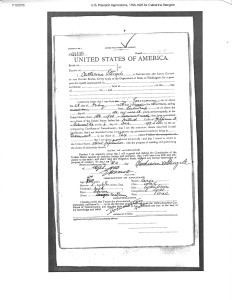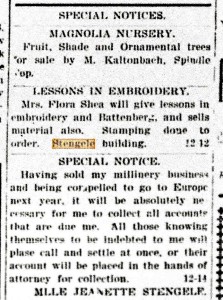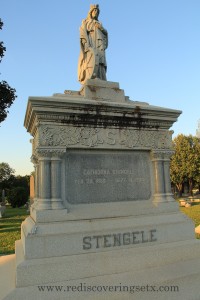My first introduction to Miss Stengele was on a cold morning during a walk through Magnolia Cemetery. As the story goes, she was a lowly seamstress who worked hard to save her money. In her short 43 years of life, she purchased a costly St. Catherine of the Wheel statue for her mausoleum, along with the twelve plots near her intended resting place, all of which she had tiled in.
Sounds like an amazing story, right? Well it is, so let us throw the rumor out and try to ascertain the facts.
 Early Beaumont was home to an entrepreneur in the form of the youthful Miss Stengele. According to her naturalization form, she arrived in this country in 1884, spent a few years in Baltimore learning the millinery business, and then moved to Beaumont in the late 1880s. The form also shows she was born on February 28, 1856, and not 1866 as stated on her mausoleum. (I suppose, even in death, some need to hold onto their youth.) Her country of origin is also unclear because of contradictory documentation. I have found some papers stating that she was from Germany. Others indicate that she was from Holland. My belief is that she was probably born along the present German–Holland border, which was initially a part of Germany but later became Holland.
Early Beaumont was home to an entrepreneur in the form of the youthful Miss Stengele. According to her naturalization form, she arrived in this country in 1884, spent a few years in Baltimore learning the millinery business, and then moved to Beaumont in the late 1880s. The form also shows she was born on February 28, 1856, and not 1866 as stated on her mausoleum. (I suppose, even in death, some need to hold onto their youth.) Her country of origin is also unclear because of contradictory documentation. I have found some papers stating that she was from Germany. Others indicate that she was from Holland. My belief is that she was probably born along the present German–Holland border, which was initially a part of Germany but later became Holland.
Miss Stengele was certainly competent in the world of business. As a single woman in the 1890s, she made a good living in her millinery business, and other ventures in the financial and real estate sectors which also seemed to work well for her. She was so successful in finance that she placed an ad in the Beaumont Journal in May 1899 stating that she was “Going to quit the business! I am going to quit the millinery business, and from the date will sell my entire stock at very low prices.”
Catherina Jeanette Stengele seemed to be a natural at finance and the lending market. So much so that she quit her day job, so to speak. Her investments would even finance a return trip to Europe in 1901. See the article in the Beaumont Enterprise dated January 6, 1900. 
You may notice the name Stengele Building, highlighted in yellow above the article. Miss Stengele also owned a three-story brick building at 345 Pearl Street in Beaumont, which had housed her millinery shop as well as several of her tenants.
While records from 1900 until her death in 1909 tell a tale of a successful businesswoman, not every investment would always go as planned. For instance, around 1905–6, records of court proceedings show the bankruptcy of the Nederland Rice farms after finishing the procedure to file for bankruptcy in which she held a $20,000 stake. Unfortunately I haven’t yet had the time to research the court files in detail, but this is on my to-do list.
In April 1909 Miss Stengele left Beaumont for Los Angeles because of an illness. An article from the Houston Post dated September 16, 1909 states she “underwent two surgeries for appendicitis during the summer.” Unfortunately Miss Catherina Jeanette Stengele had passed away the day before the article was printed, on September 15, 1909.
I found a few articles from the Beaumont Journal that explained the highlights of life and the aftermath of her death, but her will is undoubtedly of considerable interest. According to hearsay, she was at odds with one of her brothers and left him nothing, but technically that’s not true. Browsing through her will, I found that she did leave a detailed list of her heirs and her final wishes. Her wish for the St. Catherine of the Wheel statue was originally included in the first draft of her will in 1908, but the mausoleum was only added in May 1909. She had many family members, both locally and in Holland, to whom she bequeathed her wealth. Her assets were around $120,000. That’s the equivalent of $3.1 million today. Not too bad for a lowly seamstress… or should I say, a milliner?


You must be logged in to post a comment.